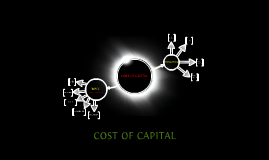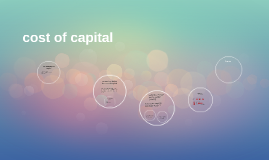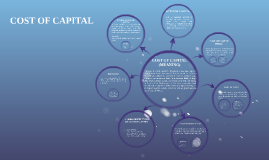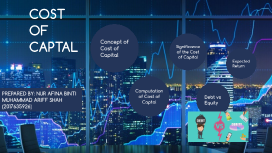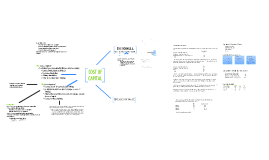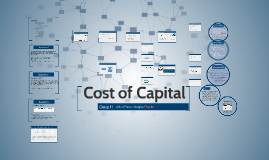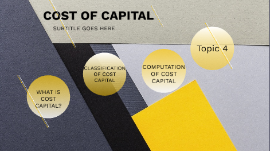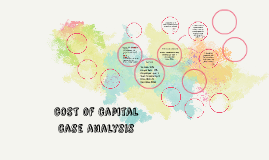cost of capital
Transcript: Background Common stock (Brigham and Houston, 2009) Debt Common stock 1. Market Interest Rate 2. What is the cost of debt? Interest expense is tax deductible = (1 – 0.4)*10% = 6.00% (after tax costs) Cost of Capital Formula for WACC Introduction Firms cannot control Interest rates in the economy The general level of stock prices Tax rates Firm can control Capital structure Dividend payout ratio Capital budgeting decision rules “Broadly speaking, a company's assets are financed by either debt or equity. WACC is the average of the costs of these sources of financing, each of which is weighted by its respective use in the given situation. By taking a weighted average, we can see how much interest the company has to pay for every dollar it finances.” You are an assistant to the VP of Finance at Coleman Technologies. In order to assess the company’s expansion strategy your task is to estimate Coleman’s cost of capital: Alfred Fraser, Douglas Ebanks where: D =preferred dividend P =dividend by the current price of the preferred stock Overall WACC Flotation s What goes into WACC calculations? P/S 9% > 6% Debt If the tax rate = 40% Then, Where: T = the firm’s marginal tax rate rd = interest rate on the firm’s new debt ( = before-tax component cost of debt ) rp = component cost of preferred stock rs = component cost of common equity raised by retaining earnings wd, wp, wc = target weights of three types of capital Debt Preferred stock Retained earnings Common stock Thank you Preferred issue is a perpetual Preferred dividends are not tax deductible, so no adjustment is needed Use nominal rates to be consistent Consistent approach for all calculations (NPV, DCF) p 4. Implied cost of equity capital Cash flows and rate of return calculations should be done on a after-tax basis. Cost of debt (interest expense) is tax deductible, therefore multiplied with (1 – tax rate). Only current, marginal costs are used for WACC calculations, not historical costs. 10% x (1-40%) = 6.00% Outline Preferred stock Definition of Flotation costs Investment bankers’ fees Not an issue, BUT substantial Approaches Factors that affect the WACC If the following conditions are met: The project can match the average risk/return profile The previous projects are sufficiently large 2 r = Bond yield + Risk premium = 10.0% + 4.0%=14.0% However, the coincidence is extremely small. Preferred stock s 2. Bond-Yield-plus-Risk-Premium approach Background Components of the WACC WACC = APPROPRIATE DISCOUNT RATE Background 3. Overall WACC Group 11 After tax adjustment Common stock Retained earnings Can WACC be used as a hurdle rate? Adjust the cost of capital Components Our 10% pre-tax estimate is the nominal cost of debt, EAR = 1.05 – 1.0 = 0.1025 = 10.25% Debt Capital Asset Pricing Model (CAPM) Bond-Yield-plus-Risk-Premium approach Discounted cash flow (DCF) approach Implied cost of equity capital Background Flotation Costs (Source: investopedia.com) Conclusion WACC could be used as a hurdle rate Reference For a closely held company(CAPM not applicable); this method is somewhat subjective “get us in the right ballpark” https://www.boundless.com/finance/textbooks/boundless-finance-textbook/introduction-to-the-cost-of-capital-10/valuing-different-costs-88/the-cost-of-new-common-stock-379-3902/ http://www.information-management.com/issues/2007_58/master_data_management_mdm_quality-10015358-1.html http://2012books.lardbucket.org/books/finance-for-managers/s12-04-cost-of-common-stock.html http://en.wikipedia.org/wiki/Weighted_average_cost_of_capital http://www.stockresearching.com/2013/11/23/google-inc-fundamental-analysis-wacc-cost-of-debt-and-cost-of-equity-goog/ http://www.valuebasedmanagement.net/methods_wacc.html Wang, P. (2013): Estimating Firm-Specific Implied Risk Premium Brigham, E. and Houston, J.(2010) Fundamentals of Financial Management (Custom Edition). South Western Cengage Learning. ISBN 9781408039137. Please note that this book is only available in the University bookshop. Approaches N = 30 (15x2, because we have semiannual payments) PMT = 60 (12% Coupon x 1000.00 FV, divided by 2 = 60) PV = - 1153.72 FV = 1000.00 YTM = 5.00002% x 2 (because of semiannual values) ≈ 10% p.a. p Overall WACC Common stock Common stock Debt The risk premium (r - long term bond yield) is typically between 3% and 5% Component cost of common equity 1. CAPM approach Any question? Definition of WACC Overall WACC Add flotation costs to a project’s cost P/S 9.00% < 10% Debt Flotation Flotation






